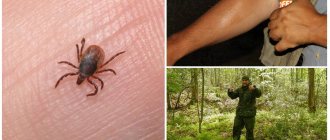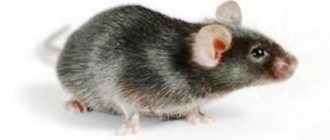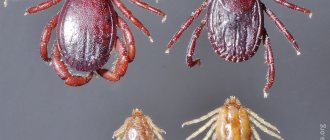Demodicosis is a parasitic disease caused by demodex mites. Almost all animals have subcutaneous mites, and under a number of factors they become active and begin to multiply, causing inflammation of the skin, itching, and hair loss.
The disease is contagious, and therefore requires isolation of the infected individual from others, as well as sterilization due to the transmission of the disease by inheritance. To stop the disease, it is necessary to begin treatment as soon as possible using modern medicines.
By following the veterinarian's recommendations, it is possible to achieve complete recovery in almost 100% of cases.
Causes
The disease is provoked by weakened immunity, stress, hormonal imbalances, diseases of the gastrointestinal tract and oncology. The disease is transmitted in the following ways:
- from the mother in utero or after birth,
- contact from a sick individual,
- through food, bedding, care items.
Often, owners acquire already sick animals, which may not show symptoms, but they become a source of spreading demodicosis to others.
Where do parasites come from in decorative rats? Precautionary measures
training rats - perhaps at the right time, thanks to training, the rat will not eat what it does not need.
How and where do they come from? Most often - from the filler that you use in the cage (we are talking about natural fillers - hay and sawdust). Inexperienced owners, in order to save money, purchase them not in special stores, but at sawmills. The result is infection of animals, since such material is not disinfected in any way. It is also easy to bring dangerous animals on your own body from the street. So the main ways to prevent misfortune are to use a safe litter and wash your hands thoroughly before each contact with the animal.
Treatment
The approach to tick control must be comprehensive. Most often, veterinarians prescribe:
- ivermectin injections in a course - usually from 2 to 6 injections every 10 days,
- treating the affected areas with acaricidal agents, for example, fipronil or permethrin,
- vitamin therapy to strengthen the immune system after complete recovery.
We also carry out analysis and correction of living conditions, disinfection of the cage, replacement of bedding, cleaning of feeders and drinkers. It is important to keep the area clean and tidy to prevent ticks from breeding. Following the veterinarian's recommendations brings the chances of recovery closer to 100%. In the absence of therapy, death occurs due to exhaustion and overstimulation of the nervous system. The pet gradually loses its aesthetic qualities - there is total hair loss, exhaustion as a result of refusal to eat, and constant anxiety due to itching.
Rat mite (Ornithonyssus bacoti) – what it looks like, life cycle, habitat, features
This is a small tick, the body length does not exceed 1.44 mm, but individuals with a length of 0.78 mm (females) and 0.53 mm (males) are more common. Offspring parameters:
- eggs – 0.34 mm;
- larvae – 0.3 mm.
Rat mites, like other representatives of the order, are covered with sensitive villi. They have 4 pairs of limbs, but the front 2 legs are longer. The outer covers are transparent light brown. After eating, the tick enlarges several times, and the color changes to dark red.
The parasite climbs onto the host when it needs to get a portion of food. It has a piercing-sucking type of mouthparts, which allows it to pierce the skin and suck out blood at a rapid pace, since the digestive system works on the principle of a pump. It is found in temperate and tropical climates, but does not live in cold regions. The main host is a rat (gray).
In the absence of a food source,
the parasite transfers to the mouse. Less often it bites other rodents.
If there is no suitable food nearby, rat ticks can bite a dog or cat, and sometimes a person. But at this stage of life the pest does not reproduce. For the birth of offspring, the blood of rodents is necessary. Moreover, the life expectancy of a person is 1.5 months. Life cycle of pests:
- egg;
- larva;
- protonymph;
- deutonymph;
- imago.
Moreover, the development cycle is short - about 16 days, sometimes less (from 7 to 12 days), which is determined by the ambient temperature. Most often, such pests live for 2.5 months, but the lifespan of males can be reduced to 45 days. Females, on the contrary, can survive for 9 months. They lay up to 100 eggs during this period, but they do this not at once, but in batches one at a time.
Rat ticks can carry serious diseases
Attack of rat ticks on adults and children - complications
Soon after a bite, people develop dermatitis of unknown etiology. Moreover, they are complicated by severe itching, the formation of papules, vesicles, and rashes over large areas of the skin. Bite marks are found where the fabric of clothing adheres more tightly to the outer skin. At the same time, a hyperemic area appears. Less frequently, the temperature rises and headache appears. This is caused by the body’s reaction to the substance introduced by the rat parasite (in saliva), as well as harmful microorganisms that the pest carries on its body.
Rat mite (Ornithonyssus bacoti)
What medications are used to make you feel better after bites?
When rat mites attack a person in an apartment, you need to use the most effective means with antiseptic, antimicrobial and antiparasitic properties:
- Benzyl benzoate ointment;
- Sulfuric ointment;
- Wilkinson's ointment;
- Bensocryl;
- Salicylic-zinc paste;
- Spregal.
What and with whom can the reaction to rat bites be confused?
When traces of contact with parasites appear, it is important to recognize who exactly attacked. If the tick has already crawled away, you need to be guided by the external signs of bites. A red spot remains with a dark dot in the center. These are nonspecific signs characteristic of most parasites. At the initial stage (during the first day), the bites of the rat parasite resemble traces of contact with mosquitoes and midges. But in the first case, the affected areas of the skin do not change much. In comparison, dermatosis caused by rat pests develops dermatitis later.
Midge bites
more painful, the affected tissues soon swell.
Rat tick bite on a human body
Rat mites can be a carrier of very dangerous diseases for humans.
Such parasites are carriers of pathogenic microorganisms, and they also pose a danger to humans. Diseases spread by such pests:
- rat typhus;
- Q fever;
- Lyme disease;
- icteric leptospirosis;
- smallpox or vesicular rickettsiosis;
- tick-borne encephalitis;
- West Nile fever;
- tularemia;
- plague.
Rat mite (Ornithonyssus bacoti)
An obligate temporary ectoparasite of rats, capable of feeding on the blood of other mammals. It was first discovered in Australia. But rats are not endemic to Australia. It’s just that some diseases were not previously associated with this type of tick. The rat mite was later identified in the United States as a source of dermatitis in humans. A few years later, it caused people to become ill in Hamburg.
The parasite was first discovered in 1913 due to its size. The length of its body is only 0.75-1.44 mm. If you look at the photo of a rat tick, it turns out that it is very similar to the common ixodid tick. There are also differences:
- there is no segmentation between the body and chelicerae;
- oval genital shield;
- cranial anus;
- pointed tail apex.
Rat mite
The color of sucked ticks is not light gray, but dark red in females or yellow in males. Hungry parasites are gray in color. After feeding, they are unable to move; when hungry, they are very active.
Major rat parasites
In decorative rats you can find different types of ectoparasites, all of which cause unbearable itching and anxiety to the animal.
lice eaters
Red wingless small insects no larger than 1 mm in size with an oblong elongated body covered with bristles, shaped like cat fleas. In light-colored rodents, adult insects can easily be detected in the fur. Rat pests feed on particles of the epidermis and blood of the rodent.
Infection of domestic rats with lice eaters is accompanied by severe debilitating itching in the rodent; the domestic rat becomes very restless, twitchy, often itches intensely, refuses to eat, and progressive exhaustion is observed. There are numerous wounds, scratches, and bruises on the pet’s body, accompanied by severe swelling and inflammatory processes.
Lice eaters in rats multiply rapidly; an adult female lays more than a hundred nit eggs, which stick to the animal’s fur. The owner can detect light shiny inclusions on the lower back and near the tail, fixed in the pet's hair and reminiscent of ordinary dandruff. It is almost impossible to remove nits from a rat's fur, only by completely removing the animal's hair. A huge number of larvae emerge from the eggs, which within a month become adult, sexually mature individuals.
The parasitism of lice eaters in rats is dangerous due to the death of the pet, so treatment should begin at the first characteristic symptoms of infection.
Lice
Lice in rats cause severe itching and anxiety; these parasitic insects feed only on the blood of a domestic rat; per day, one louse attaches itself more than 10 times to the animal’s skin. Adults can only be seen under a microscope; the body size of the parasites is no more than 0.5 mm.
Rat lice are small red insects with an elongated body, at the head end of which there are hooks for holding on the animal’s body and two sharp stilettos for piercing the skin. The louse cuts through the skin, injects substances that prevent the rodent's blood from clotting, and attaches itself to the animal's body.
Reproduction of lice occurs in the same way as in lice, with the deposition of nit eggs and the hatching of nymphs, which turn into sexually mature individuals. White shiny nits of lice can be found on the fur of a rat; parasitism is accompanied by severe nervousness of the animal, active itching, lethargy and apathy of the pet; the development of anemia, typhus and hemobartonellosis in the rat is possible.
Fleas
Rat fleas are unpleasant blood-sucking insects of a red-brown color with a characteristic body flattened on both sides, the size of the insect is 2-5 mm. The flea is capable of jumping long distances and clinging to the host's fur with tenacious claws, and is capable of migrating between cats, dogs and rats.
When infected, pets constantly scratch itchy areas, become restless, and may develop anemia. Dried burgundy crusts can be found on the animal's body - flea secretions; when bathing a rat, they turn the water pink.
Mites are very common in rats; there are several types of parasites that live on the skin and in the epidermal layer. The rat tick is red-brown in color, 0.1-1 mm in size, has an oblong flat body, feeds on the blood of an animal and carries various serious diseases. With a lack of nutrition, the tick is capable of attacking humans.
IMPORTANT!!! Rat mites are dangerous to humans! People, especially children, have a hard time with eczematous dermatitis, which develops as a result of parasitism by these insects. Ticks infect people with typhus and murine typhus, tularemia, plague, rickettsial infections and Q fever.
Subcutaneous mites live in the upper layer of the epidermis under the skin of a rodent. It is impossible to visually detect these mites; the diagnosis is made only on the basis of examination of skin scrapings under a microscope.
Parasitism of ticks on the body of a rat is manifested by characteristic symptoms: hair loss and the formation of multiple swollen red wounds on the neck, head, spine and shoulders of the rodent.
Ear mites primarily attack the delicate skin of the ear, pinna and nose, which is manifested by the appearance of yellow or red growths on the ears, nose, limbs and genitals.
Bedbugs
Ordinary bed bugs can also drink blood from decorative rats, causing severe itching, scratching, anemia, and infection with blood parasites. Bedbugs attack domestic rodents during periods of food shortage or the absence of a person nearby as a food source.
How to distinguish a healthy pet from a sick one?
A healthy pet always:
- well-groomed, shiny coat, without bald patches or tangles (if the rodent is not hairless)
- clear skin, no wounds, eczema or rashes
- clear, shiny eyes without discharge
- clean nose and ears
- clean area under the ponytail
- smooth breathing without wheezing or whistling
- moderately well-fed body, without protruding bones
- behavior is normal, without sudden changes, appetite is preserved
If you are already the owner of a small pet, then you need to adhere to the following rules to avoid diseases of your little friend.
Quarantine
- Preventive quarantine when introducing new animals into a group is 14 days. During these 14 days, animals are kept separately, regardless of where or from whom you purchased these (or one) animals, and regardless of the fact that these animals do not show any signs of illness. During these two weeks, the animals are monitored and hygiene measures are observed to prevent the transmission of possible infections through hands and animal care items. It should be remembered that hands are the main source of transmission of infections and infestations.
- Quarantine can be not only preventive, but also forced. The necessary measure is to keep clinically healthy animals isolated from clinically sick ones. Otherwise, the entire group of animals can become infected and fall ill. And then the scale of the “disaster” can become significant.
- Mycoplasma pulmonis and Streptococcus pneumoniae are pathogens that cause chronic respiratory syndrome in rodents and can be transmitted by direct contact and by airborne droplets. These pathogens infect the lungs, cause otitis media, and in females cause the development of endometritis. Mycoplasma and streptococcus are dangerous for rats, hamsters, gerbils, guinea pigs and chinchillas. Rats, often suffering from otitis media and systemic respiratory infections, become over-infected in a group and everyone gets sick.
- Chinchillas are re-infected with giardiasis and everyone in the group gets sick.
- Myxomatosis in rabbits is extremely contagious. To date, there is no effective treatment for myxomatosis. Vaccine prophylaxis is used.
Following simple quarantine rules will help keep your pets healthy and alive.
Parasitic diseases of rats
In decorative rats, parasitic diseases caused by fleas, lice, and lice are most often diagnosed. The reason for this is the lack of regular treatment of cells and household items, and unbalanced nutrition.
Fleas on rats
The causative agent of flea infestation in decorative rats is ectoparasites from the order Siphonaptera. This disease is diagnosed as aphanipterosis. It is accompanied by dermatitis, since flea saliva contains toxic substances that cause allergies in the rodent.
The danger of flea infestation is that one flea can drink up to 11–16 μl of blood per day. And with mass reproduction, this can cause anemia in a decorative rat.
Aphanipterosis is accompanied by itching, which leads to scratching on the skin. When bacteria and infections get into open wounds, they begin to fester. This leads to a chronic relapsing course of the disease.
Lice and lice in rats
Infection of a decorative rat with lice and lice-eaters is diagnosed as pediculosis. The incubation period of the disease can last about a month.
Main symptoms of the disease:
- constant itching;
- red dots, scratches in the muzzle, neck, shoulders;
- anemia, causing weakness, drowsiness;
- refusal to eat;
- sudden weight loss.
The danger of pediculosis is that its pathogens are also carriers of diseases such as typhus and hemobartonellosis.
Weight loss
Bed bugs on rodents
Bedbugs are very rarely found on pet rats. Like fleas, a rat will only have bedbugs if another pet (such as a dog or cat) has them.
Make sure all your non-rat animals are on a high-quality flea (and bedbug, if necessary) preventative. Over-the-counter products are not always effective or safe. The best flea and bedbug treatments are recommended by your veterinarian. If your dogs and cats don't have fleas and ticks, then your rats shouldn't have them either.
How to prevent parasites
To ensure that your pet does not have a negative experience of being infected with parasites, you should take care of keeping the animal comfortable in the apartment and strictly follow the following precautions :
- keep the cage clean - clean the inside in a timely manner and periodically disinfect it;
- change the water in the drinking bowl more often;
- provide the rat with adequate nutrition;
- ventilate all rooms daily;
- every time after returning from the street, wash your hands and take off dirty clothes, especially before interacting with your pet;
- and another important condition is to purchase fillers and food exclusively in zoological stores with a good reputation.
Pet pathologies
Rats and mice living at home do not like drafts and are susceptible to respiratory diseases. Initial grunting, snoring, and wheezing quickly develop into pneumonia with a high risk of death.
Decorative mice suffer from a viral infection - mousepox, which ends in death in 80-90% of cases.
Infectious diseases of rats and mice:
- Tuberculosis.
- Arachnoses (parasites).
- Pneumonia, ARVI.
- Mycoplasmosis.
The constant companions of wild rodents are skin parasites (ticks, fleas, lice eaters) and ringworm. Pets are also sensitive to them, but diseases appear if they are poorly maintained.
Tumors of various origins, problems with teeth, gums, and urolithiasis are diagnosed as non-infectious diseases. Older rats suffer from cardio-renal failure and obesity, which is not surprising given a sedentary, well-fed lifestyle. This manifests itself in dysfunction of the respiratory system, water retention and swelling. You need to pay attention to the gastrointestinal tract, especially with improper feeding.
Diseases
The parasite's bites cause an itchy skin irritation in humans called rat mite dermatitis. Children may have an eczematous or vesicular reaction to the sting. Rat mite attacks must be differentiated from other insect bites or skin irritations caused by the body's reaction to an allergen.
Treatment of rat tick-borne dermatitis is symptomatic. To alleviate the condition of the victim, use:
- oral antihistamines;
- topical corticosteroids;
- benzyl benzoate;
- gamma-benzene hexachloride;
- Crotamiton.
But often the irritation goes away on its own or people simply do not react to the saliva of rat bloodsuckers.
Rat mite
The reaction to rat parasites must be separated from the symptoms:
Laboratory studies have also shown that rat mites can carry dangerous diseases:
In unfavorable times, rat ticks, along with fleas, were the main carriers of typhoid and plague from rodents to people.
Prevention measures
Preventing the occurrence of rat mites primarily involves timely getting rid of rodents that carry them. Includes the following measures:
- Control over the size of the rat population and constant measures for deratization in areas inhabited by rodents.
- Isolation of premises from rats. The sealing of manholes is carried out by residents.
- Maintaining premises in proper sanitary and technical condition.
You should know that rat mites reproduce in warm conditions and in the presence of food. It can develop all year round, but is especially active in the spring. Parasites are very easy to disinfest and die almost immediately. Most often, to get rid of them, a one-time treatment of the premises is enough. However, after a while they may appear again if preventive measures are not followed. If ticks reappear, acaricide treatment is carried out again.
Sources
- https://misterklop.ru/klesshi/krysinye-i-myshinye-kleshhi-kto-eto-kak-vyglyadyat-na-chyom-parazitiruyut-mogut-li-prichinit-vred-cheloveku-sposoby-borby-v-domashnih- usloviyah
- https://likehamster.ru/domashnie-krysy/o-zdorove/parazity-u-krys-kak-borotsja/
- https://parcenter.ru/myshi-i-krysy/kleshhi-u-dekorativnyh-krys.html
- https://homkin.ru/krysy/zdorovie-krys/blohi-vlasoedy-vshi.html
- https://hlopklop.com/zhiv/krysinye.html
- https://dezplan.ru/vopros/krysinye-kleshchi-foto-ukusov-i-lechenie
- https://TezarVape.ru/ektoparazity/kleshchi-u-krys.html
- https://sichovka.ru/parazity/gamazovye-kleshchi.html
[collapse]
How to treat an infected rat
It is advisable that the treatment of an infected rodent be carried out by specialists from a veterinary clinic. A doctor who deals with the recognition and treatment of rodent diseases is called a ratologist. He will clarify the type of parasite, prescribe the most effective tactics and recommend a drug that will help a specific breed of domestic rat. But if for some reason you do not have the opportunity to contact a specialist, you can treat your pet yourself.
Find out why your pet rat itches.
What can be processed
If signs of the presence of parasites are detected, you need to get rid of them using the following effective medications:
- “Unoiled.” Dilute 2 ampoules with water, then thoroughly treat the entire surface of your pet’s body. Pay special attention to damaged areas of the skin. Keep the rat wrapped in a towel until the solution dries. This is necessary in order to prevent the animal from licking the drug. After 10 days, repeat the procedure.
- "Frontline" (spray). Spray the product twice on your pet's body. Hold the rat in your arms until the preparation dries. After 7–10 days, repeat the procedure.
- "Bars" (insectoacaricidal spray for cats and dogs). The solution must be sprayed onto the withers and also wiped over the affected areas of the skin. Repeat these procedures after two weeks.
A separate group of drugs has been developed to combat subcutaneous and ear mites:
- "Stronghold" (drops, bottle comes with a purple cap). Dosage at the withers - 0.01 ml per 100 g of animal weight.
- “Lawyer” (drops on the withers).
- “Dironet Spot-on” (drops on the withers).
- "Prasicide-complex" (drops). One application is enough to save the animal from subcutaneous ticks.
If parasites are detected on one pet, all animals living in the house will need treatment. In addition, it is important to carry out general cleaning and disinfection in all rooms. The cage, feeder, water bowl and all toys must also be disinfected. And the bedding and filler need to be changed. All wooden objects in the cage (sticks, toys) should be removed from the house.
Important! During the treatment period, the rat's claws must be trimmed to prevent scratching of the skin.











